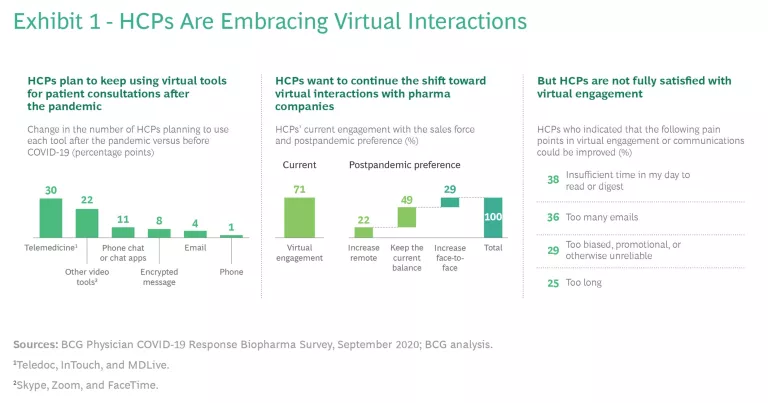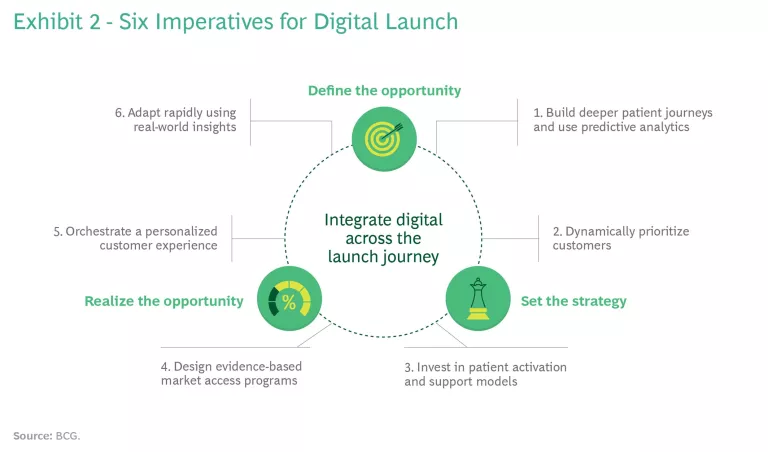Since the onset of the pandemic, leading biopharma companies have demonstrated what works in digital launches. The industry should apply these lessons learned as it adapts to the behavioral changes triggered by the crisis. These shifts will likely persist to some degree: three-quarters of physicians surveyed by BCG about the implications of COVID-19 plan to continue using virtual channels to interact with biopharma representatives—or even increase the use of digital communication—after the pandemic.
In the new reality, weaving digital and analytics into every aspect of a product launch will be a prerequisite to engaging with customers and a major source of competitive differentiation. Winning companies will use digital to deepen their understanding of patient journeys and customer preferences, promote data-driven decision making, and provide personalized experiences to health care providers (HCPs) and, where appropriate, patients. Six steps capture the essential actions to make it happen.
THE RISE OF VIRTUAL ENGAGEMENT DEMANDS A DIGITAL LAUNCH
The imperative to digitize medical affairs, sales, marketing, and other stakeholder interactions is not new. For at least the past decade, biopharma companies have invested heavily in digital tools, mainly to supplement traditional face-to-face exchanges.
What’s different today is the extent to which the pandemic has accelerated HCPs’ adoption of virtual ways of working . (See Exhibit 1.) In BCG’s physician survey, most respondents said that they are engaging virtually with biopharma reps, and a large majority plan to continue doing so after the pandemic.
The new importance of virtual interactions has significant implications, particularly for launch planning. For example, the greater use of virtual patient consultations may create fewer opportunities for physicians and patients to discuss trying new medications when current treatments are not providing optimal outcomes. Moreover, HCPs are overwhelmed by the increasing volume of digital content and have less time to filter and read lengthy, generic communications from biopharma reps; they want more targeted communication and scientific content. Understanding how customers prefer to engage in a post-COVID-19 world, including the extent to which they would rather have virtual versus in-person interactions, will be critical for biopharma launch planning.
A Biopharma Company Lays the Foundation for A Digital Launch
Creating a solid basis for launch has always been table stakes for ensuring that a product achieves its potential in the market. This includes:
- Defining the Opportunity. Using data to better understand the patient journey and how a new product could best fit into that.
- Setting the Strategy. Clearly defining strategic priorities for the brand, including the following: determining which patients would benefit and how best to support them in getting the therapy they need, deciding how to segment HCPs, establishing product positioning and messaging, as well as addressing access, distribution, and pricing.
- Realizing the Opportunity. Ensuring that the right resources and tactical plans are in place to activate the organization and achieve the strategic priorities at product launch.
The digital imperative has raised the bar for executing a successful launch, making this foundation more essential than ever.
The digital imperative has raised the bar for executing a successful launch, making a solid foundation more essential than ever.
A leading biopharma company used this framework to successfully launch several products in oncology and other specialty therapeutic areas. For each launch, it tailored the areas of strategic focus to fit the product context.
The company gained deep market insights through traditional market research and claims data analysis, enabling it to understand patient journeys, customer behaviors, and the market access landscape. This provided the basis for prioritizing target customers and defining strategic launch priorities. The company also used an effective go-to-market approach to align cross-functional launch tactics with strategic priorities and coordinate customer touch points across teams, often at the field level.
An internal launch office was set up to foster cross-functional coordination and leadership engagement on key strategies and tactics. After the launch, this collaboration enabled teams to rapidly share insights from the field and monitor demand, allowing the company to seamlessly adjust priorities and messages.
As virtual and digital communications became commonplace over the past year, the company saw higher expectations from customers and an increasing need to quickly adapt to the fast-changing market landscape. Meeting this higher bar will require more in-depth and dynamic insights enabled by advanced analytics and increasingly personalized customer experiences. To accomplish this, the company will need to continue building on its investments in digital and analytics capabilities.
Follow Six Imperatives
This company’s challenges going forward are not unique. The increased use of digital tools and data means that all biopharma companies must apply deeper insights and create better customer experiences to be competitive and realize market opportunities. An effective approach weaves digital capabilities into each phase of the launch journey. Six imperatives capture the actions required to pursue a truly digital launch. (See Exhibit 2.)
1. Build deeper patient journeys and use predictive analytics. Analytics capabilities are essential to gain a sharper understanding of the patient journey and identify where treatments could most appropriately be used to promote the best clinical outcomes. Leading biopharma companies have started to analyze real-world data sets (such as claims and lab data or electronic medical records) to map patient journeys using real market activities rather than customer feedback. This data-driven approach provides a more accurate picture of what is happening in the market and gives decision makers insight on how the journey is changing over time.
Companies are also beginning to employ predictive models to understand which patients will benefit most from a treatment and to fill blind spots in the patient journey. These predictions enable biopharma companies to plan ahead and have more relevant engagements with customers, instead of reacting to past events. For example, a leading biopharma company leveraged real-world data to predict key oncology treatment events, such as first-line therapy failure. By enabling better engagement with physicians, the predictions can help the company achieve a 300% increase in patient access to best-in-class treatments in an area of high unmet need.
2. Dynamically prioritize customers. Traditionally, biopharma companies have developed customer target lists before launch and revised them very infrequently, even if market conditions changed. To succeed today, companies need to continually refresh these lists on the basis of new insights and a sophisticated understanding of customers. This dynamic targeting gives marketing and sales teams a real view of the most pressing unmet needs in the market, including one-time or short- and long-term HCP needs. The lists also offer insights on which HCPs can gain the greatest benefit from education about the product at a certain point in time. Using this method, one biopharma company achieved a 5% to 10% uplift in sales.
To maximize the potential of dynamic targeting, biopharma companies should equip field teams with more engaging dashboards and improved CRM system interfaces. These tools help sales reps interact with new and deeper customer insights seamlessly and productively.
3. Invest in patient activation and support models. The increased use of virtual patient consultations may cause delays in initiating patients on a medication or supporting their transition to new drugs. To help HCPs prescribe the appropriate therapy to eligible patients, biopharma companies should design support models and tactics that allow them to provide the right education and access to assistance programs at critical times. Comprehensive support models combine the superior visibility offered by new data with the right interventions.
4. Design evidence-based market access programs. To gain a competitive advantage, companies can leverage novel analytics to analyze the historical performance of market access programs and create more targeted, impactful strategies. They can also use these insights to help more strongly articulate the value of treatments and create more effective pricing that better reflects the product’s value. In addition, they can use the advanced analytics to develop market access programs that secure more stable and affordable access for patients, such as copay programs, and adherence initiatives that minimize treatment dropouts.
5. Orchestrate a personalized customer experience. Digital tools allow companies to coordinate a personalized customer experience at the right time, through the right channel, and with the right content.
To determine the next-best action for customer engagement, leading biopharma companies are developing personalization engines, powered by artificial intelligence (AI), that analyze historical customer interaction and engagement data, as well as feedback received. The personalization engines help reps take the actions with the greatest potential impact at the appropriate time, guided by push notifications and similar internal communication channels.
To personalize the experience, biopharma companies are also evolving their content strategy to focus on the most strategic messages and tailor content for each channel, such as email, video call, and on-demand interactions. An up-to-date understanding of HCPs’ content preferences is essential. BCG’s physician survey found that almost all HCPs regard scientific data and medical information or education as valuable and want to maintain or increase the amount they receive. Moreover, they would like to discuss this material with medical science liaisons (MSLs), not sales reps. Of physicians surveyed, 92% said that MSLs are as relevant or more so than before COVID-19.
6. Adapt rapidly using real-world insights. To enable swift course corrections of their strategy, companies need to gauge their performance quickly and frequently. Gaining visibility into changes in the size and source of demand in real time and at a granular level enables dynamic planning and resource allocation. This requires measuring demand and tracing it back to personalization initiatives and customer engagement—understanding, for example, the extent to which email outreach to HCPs leads to real-time discussions and how often these conversations result in new prescriptions. Companies can apply these insights to generate demand forecasts that provide the basis for refining strategy and tactics.
Adapt Ways of Working as Enablers
To provide agile governance, biopharma companies should set up a launch office that fosters collaboration and transparency across functions and with leadership, and ensures that actions are taken on the basis of insights and data. After the launch, this governance should remain in place to track progress and adapt strategy and tactics in response to the results. Our experience working with leading global biopharma companies confirms that agile governance is critical to a successful digital launch.
Agile governance is critical to a successful digital launch.
The right mindset is also essential for a digital launch. A company’s leadership needs to support the transition to a more digitally focused approach and ensure that digital imperatives are paramount over other launch priorities. Staff at all levels of the organization should adopt a flexible try-and-learn mentality so that they can refine digital approaches to achieve the greatest impact.
In addition, companies should foster a culture in which leaders at all levels act on data and insights in their business planning. For example, firms should encourage field teams to incorporate the insights provided by advanced analytics and act on the next-best actions recommended by new digital tools. Other enablers include establishing an employee-training curriculum to promote digital fluency and building IT capabilities to support accelerated digital and analytics initiatives.
HCPs’ new openness to digital engagement spans all markets and has clear implications for launch planning. Biopharma companies can no longer rely on traditional face-to-face activities supplemented by “surround sound” digital accompaniment. Digital launches, with new capabilities and content catering to the changing preferences of HCPs and patients, will be essential for effective customer engagement and will differentiate the industry’s winners in the coming years. Now is the time for biopharma companies to seize that advantage by weaving digital holistically into every aspect of the product launch.








